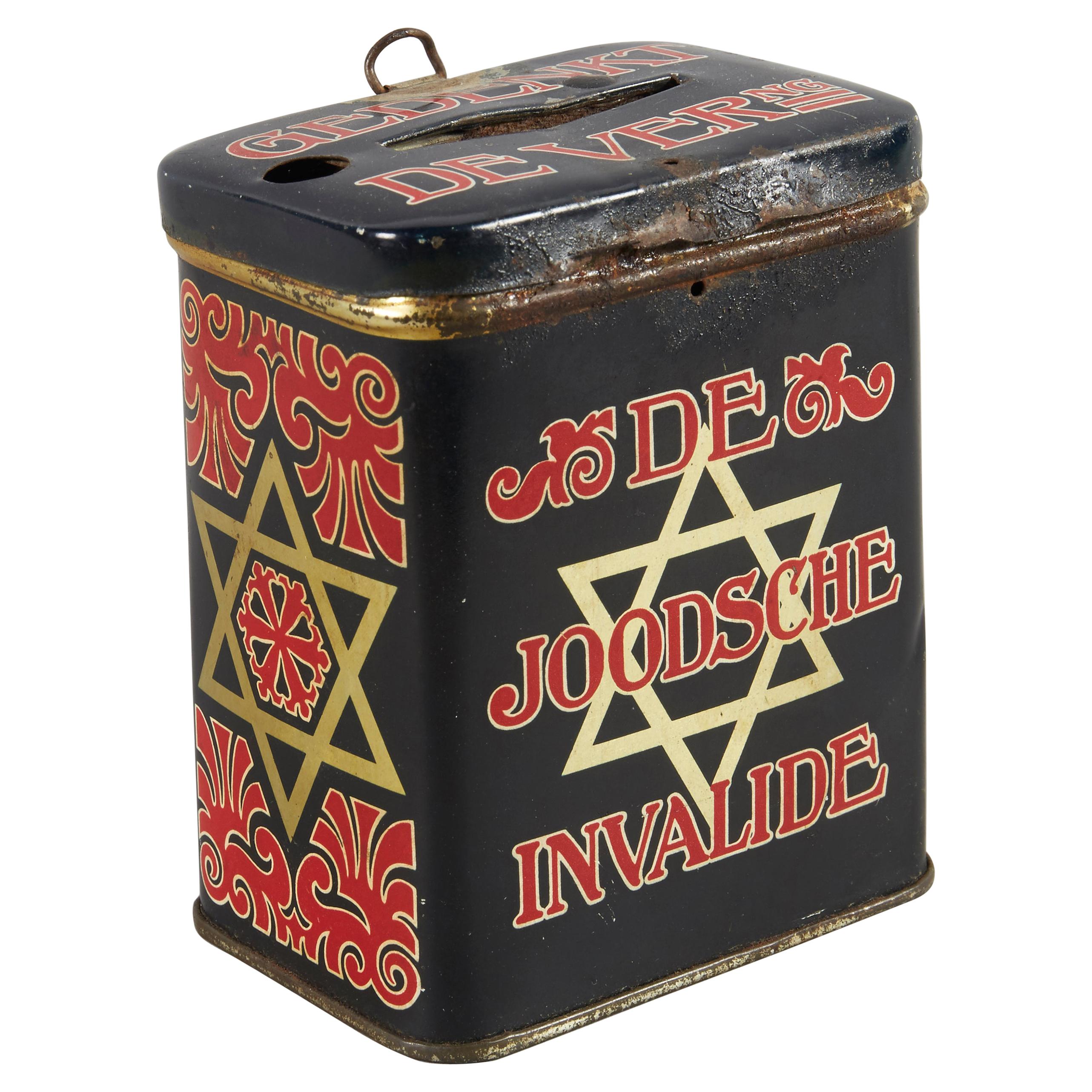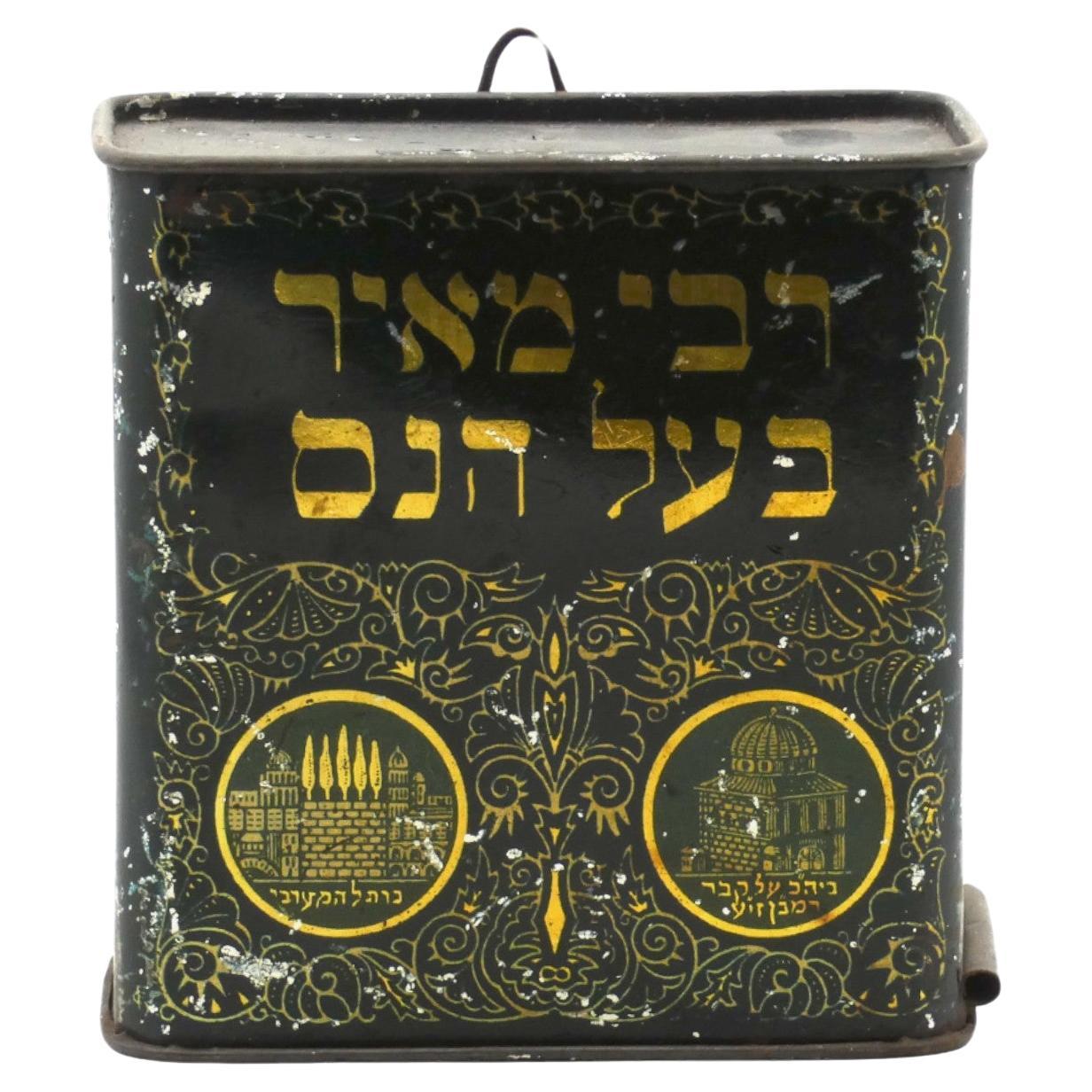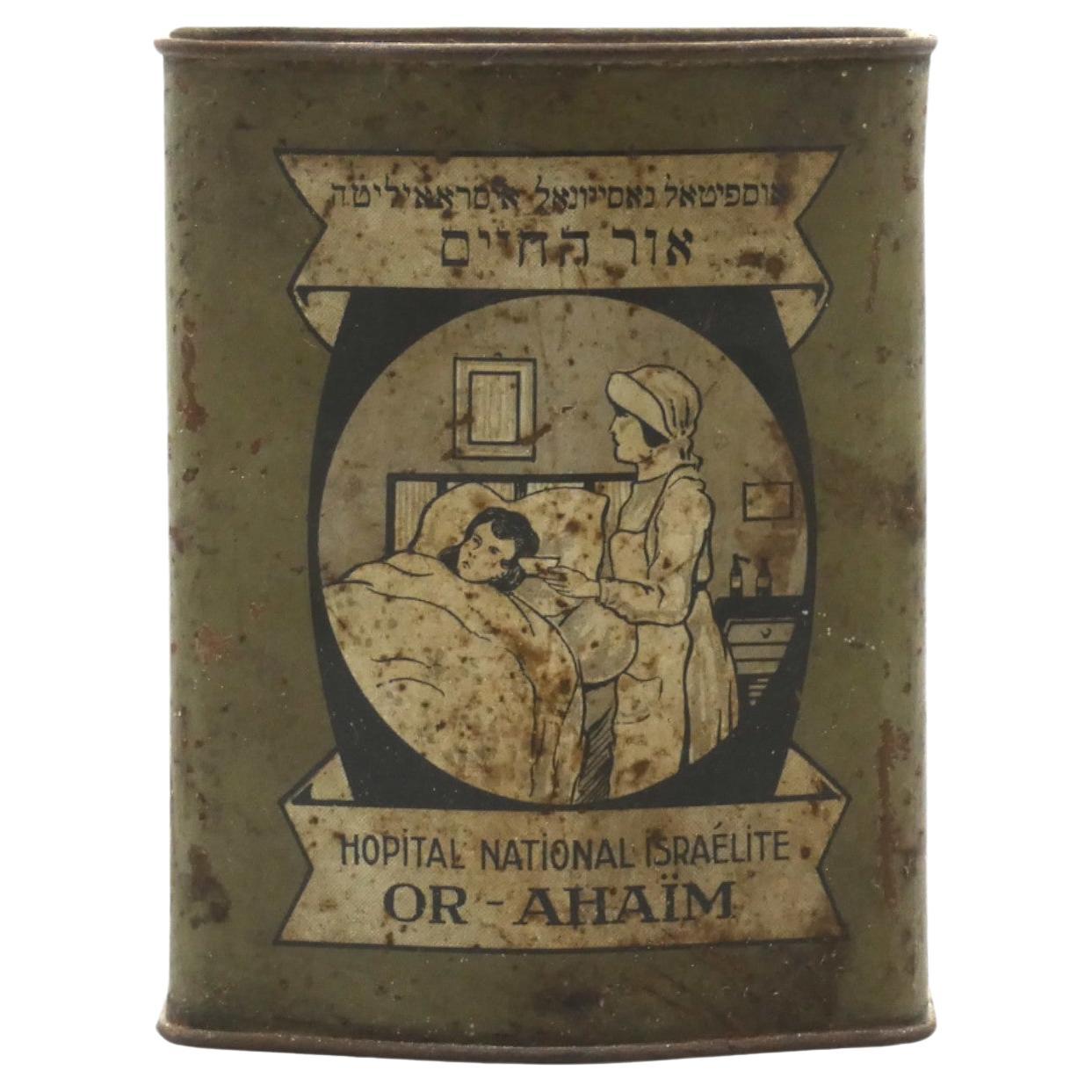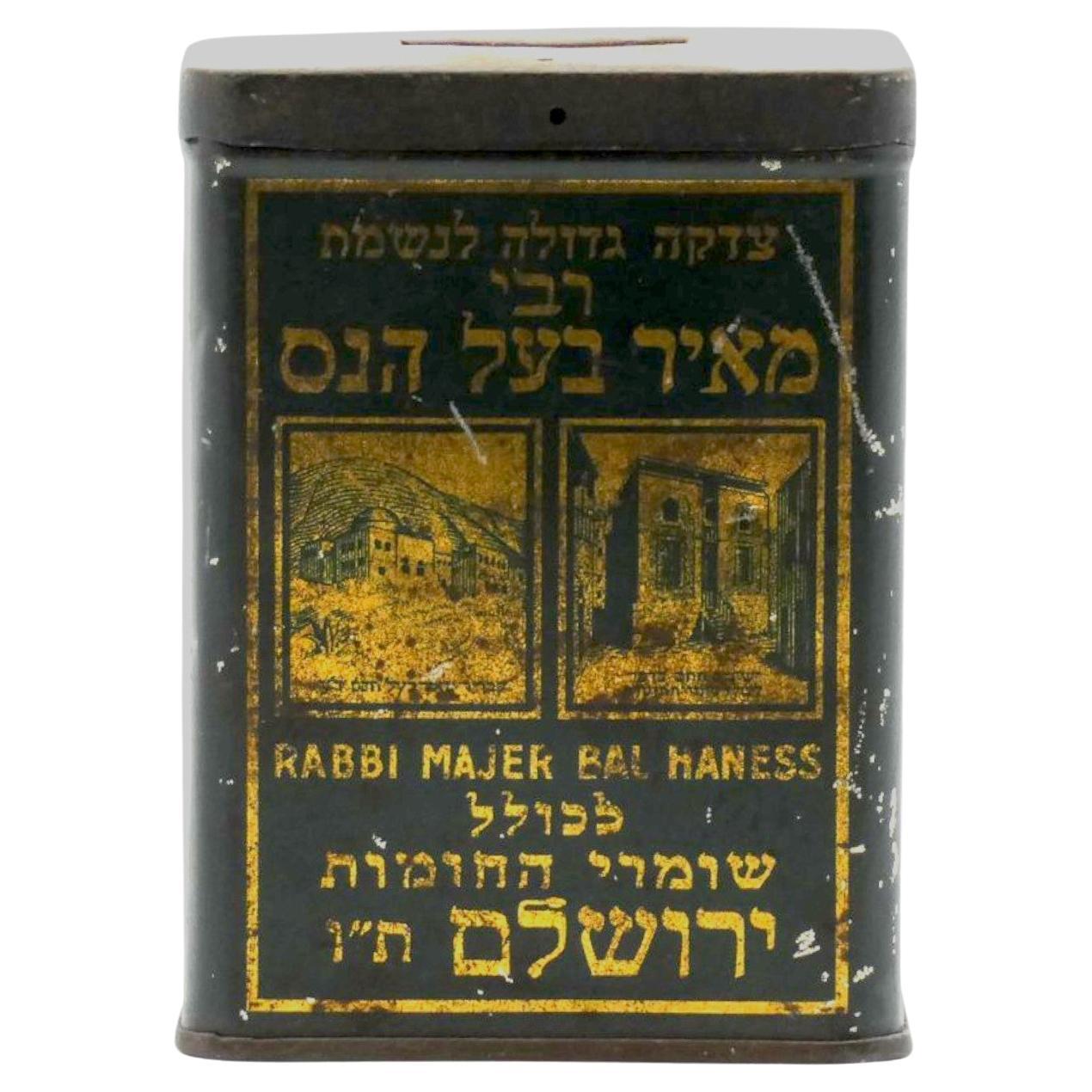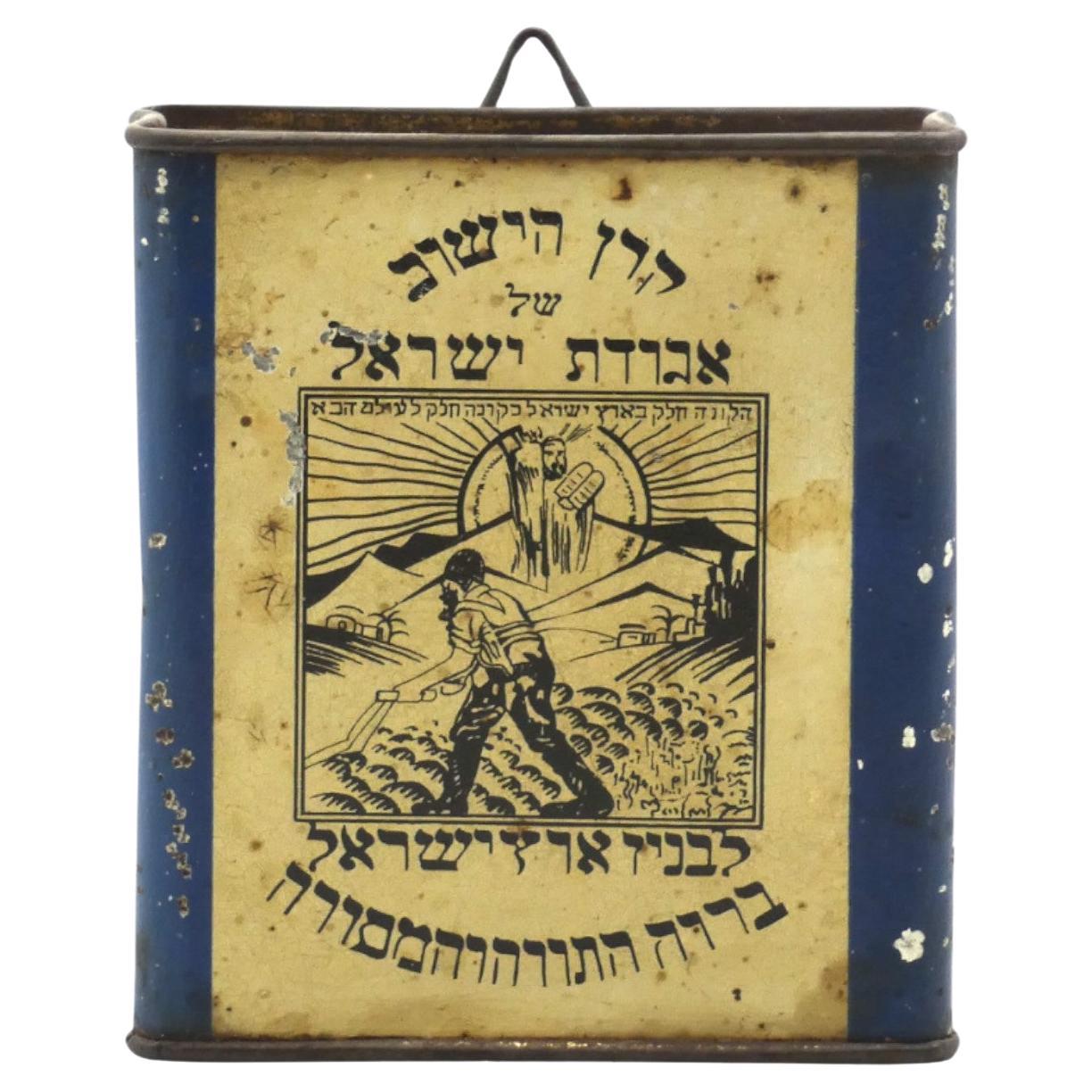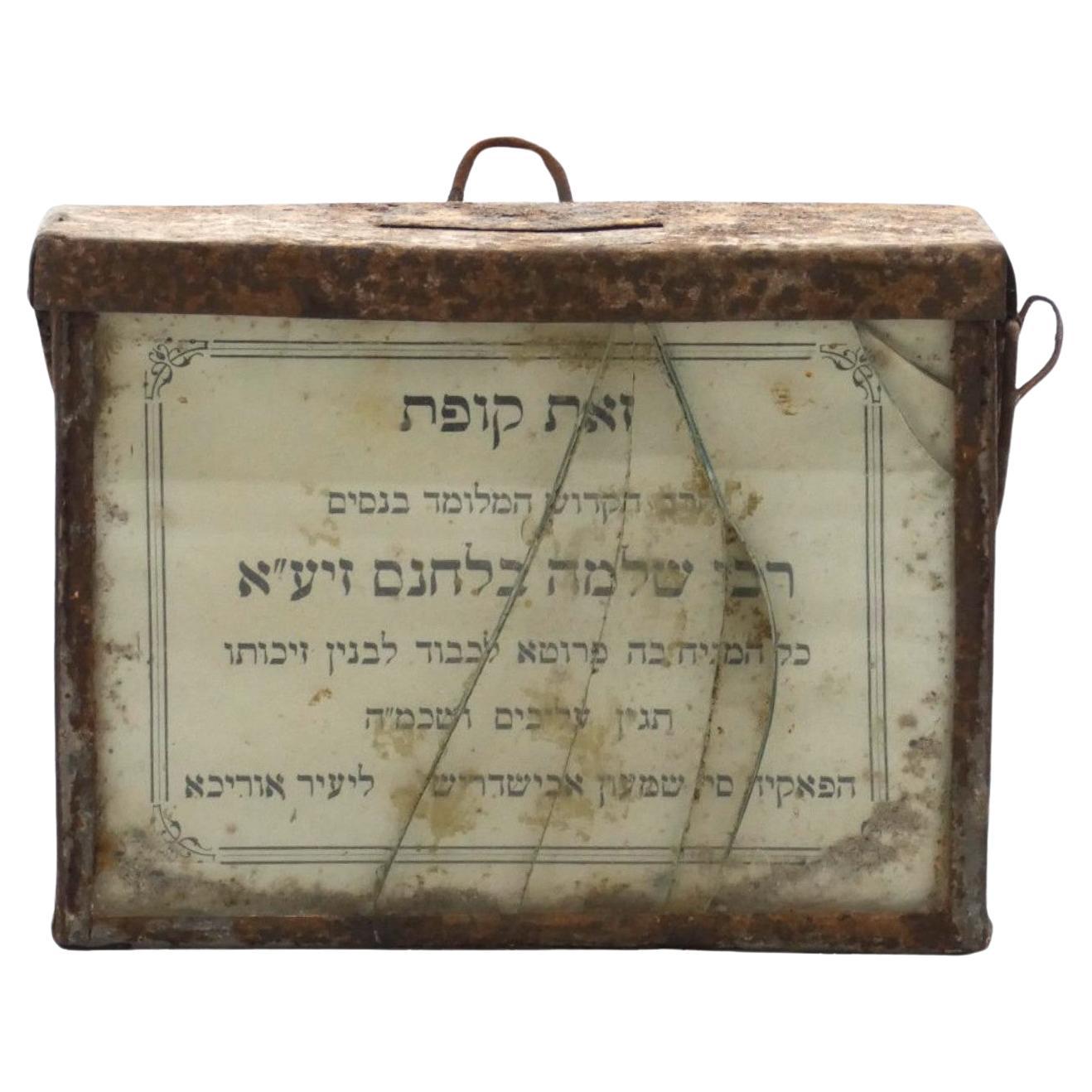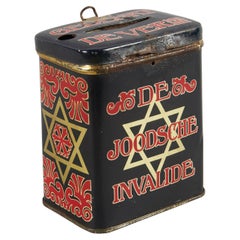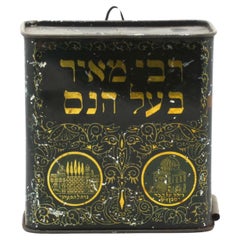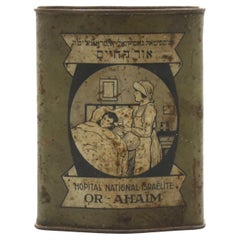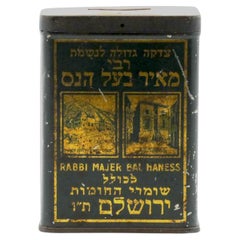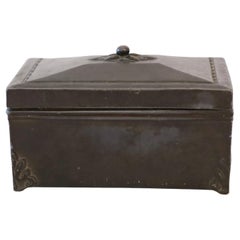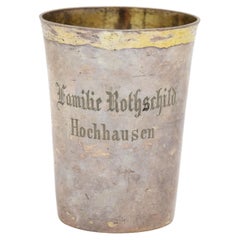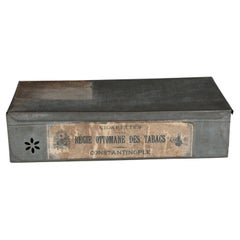Items Similar to A Dutch Jewish Hospital Charity Container, Netherlands, Circa 1920
Want more images or videos?
Request additional images or videos from the seller
1 of 7
A Dutch Jewish Hospital Charity Container, Netherlands, Circa 1920
$560
$70020% Off
£427.56
£534.4520% Off
€494.04
€617.5520% Off
CA$786.13
CA$982.6720% Off
A$876.23
A$1,095.2920% Off
CHF 459.73
CHF 574.6620% Off
MX$10,700.18
MX$13,375.2220% Off
NOK 5,821.14
NOK 7,276.4320% Off
SEK 5,501.86
SEK 6,877.3320% Off
DKK 3,687.23
DKK 4,609.0320% Off
About the Item
A Dutch Jewish Hospital Charity Container from the Netherlands, circa 1920, is a unique Judaic historical artifact.
This charity container was used to collect donations for a Jewish hospital in the Netherlands. These containers served as a means for the community to contribute funds to support medical care and services for those in need.
The container was a part of the philanthropic efforts within the Dutch Jewish community during the early 20th century. Supporting hospitals and medical institutions was particularly important in Jewish communities, reflecting values of compassion (tzedakah) and communal solidarity.
Charity container is painted black with gold stars of David on the background on all sides. "De Joodsche Invalide" (The Jewish Invalid) is painted in red on both sides with scrolling red designs on the the two smaller sides. At the top, "Gedenkt De Verng" (Thank You Very Much) is written in red with a slot for inserting donations, and a suspension ring used to hang the charity container in public areas.
Historically this charity container was made in the interwar period, a time marked by economic challenges growing antisemitism, and political instability. Such charity containers are now valuable artifacts that provide insights into the charitable practices and community life of Dutch Jews in the early 20th century. They are collected by museums and private collectors interested in Jewish history and material culture.
Numbered 1285 at the bottom.
- Dimensions:Height: 3.94 in (10 cm)Width: 3.04 in (7.7 cm)Depth: 2.09 in (5.3 cm)
- Materials and Techniques:
- Place of Origin:
- Period:
- Date of Manufacture:1920's
- Condition:Wear consistent with age and use.
- Seller Location:New York, NY
- Reference Number:1stDibs: LU5281240024112
About the Seller
5.0
Recognized Seller
These prestigious sellers are industry leaders and represent the highest echelon for item quality and design.
Established in 2006
1stDibs seller since 2020
130 sales on 1stDibs
Typical response time: 1 to 2 days
- ShippingRetrieving quote...Shipping from: Pomona, NY
- Return Policy
Authenticity Guarantee
In the unlikely event there’s an issue with an item’s authenticity, contact us within 1 year for a full refund. DetailsMoney-Back Guarantee
If your item is not as described, is damaged in transit, or does not arrive, contact us within 7 days for a full refund. Details24-Hour Cancellation
You have a 24-hour grace period in which to reconsider your purchase, with no questions asked.Vetted Professional Sellers
Our world-class sellers must adhere to strict standards for service and quality, maintaining the integrity of our listings.Price-Match Guarantee
If you find that a seller listed the same item for a lower price elsewhere, we’ll match it.Trusted Global Delivery
Our best-in-class carrier network provides specialized shipping options worldwide, including custom delivery.More From This Seller
View AllEarly 20th Century Dutch Tin Charity Box
Located in New York, NY
Black, red, and gold painted tin charity box, The Netherlands, circa 1915.
Used for collecting funds for the Jewish hospital.
Decorated with Stars of ...
Category
Early 20th Century Dutch Decorative Boxes
Materials
Metal
$480 Sale Price
20% Off
A Rabbi Meir Ba'al Haness Charity Container, Israel Circa 1920
Located in New York, NY
A Rabbi Meir Ba'al Haness charity container from Israel circa 1920 is an artifact associated with Jewish religious devotion and charitable traditions.
Rabbi Meir Ba'al Haness, also ...
Category
Vintage 1920s Israeli Religious Items
Materials
Tin
$1,440 Sale Price
20% Off
A Turkish Or-A'Haïm National Israelite Hospital Charity Container, Circa 1930
Located in New York, NY
A charity container for the Turkish Or-A'Haïm National Israelite Hospital from circa 1930 is a historically significant artifact reflecting efforts to support healthcare and charitab...
Category
Vintage 1930s Turkish Religious Items
Materials
Tin
$1,920 Sale Price
20% Off
A Tin Charity Container, Belgium Early 20th Century
Located in New York, NY
A tin charity container for Kollel Shomrei HaChomot in Belgium from the early 20th century was used to collect donations for this religious institution comprising several schools, an...
Category
Early 20th Century Belgian Religious Items
Materials
Tin
$1,200 Sale Price
20% Off
A Keren Hayeshuv Charity Container, Israel Circa 1940
Located in New York, NY
A Keren Hayeshuv charity container from Israel circa 1940 is an artifact tied to the early years of the State of Israel and its efforts to support Jewish settlement and development.
Keren Hayeshuv, which translates to "The Settlement Fund," was an organization established in Israel during the pre-statehood period and continued its activities after the establishment...
Category
Vintage 1940s Israeli Religious Items
Materials
Tin
A Moroccan Charity Container, Circa 1920
Located in New York, NY
This Moroccan charity container from around 1920 is a unique artifact that represents the containers that were often used for collecting donations or contributions for various charit...
Category
Vintage 1920s Moroccan Religious Items
Materials
Tin
$2,000 Sale Price
20% Off
You May Also Like
extremely rare Algerian Judaica silver, jewish Dowry box early 19th century
Located in Tel Aviv - Jaffa, IL
Amazing and scarce JUDAICA object, we have here one of the most touching jewish objects we had for a long time, this small silver dowry box was made in Algeria in the early 19th century, it is all covered with symbols of jewish faith and of couples, the sliding lid has 2 flanking birds with hamsa (protective hand) on each side and a flower vase in the middle.
one side shows two flanking lions with a tree in the middle and the other side shows again two big and two small birds with a flower bowl in the middle, front side has a key hole and next to it there is the Hebrew inscription ס״ט״" which says Siman tov or in English "a good sign" it is taken from the wedding blessing, underneath the lock there is another inscription with the name ״עזיזה בת אברהם בן חמו״ which is the name of the bride, her father and her grandfathers name.
the box is full marked a lot of times with the silversmith mark, every side of the box is marked.
this box was probably ordered by the grooms family to hold the jewelry they are giving to the bride as dowry, this type of objects are rare and there are just a few of them on museum collections.
DOWRY (Heb. נְדֻנְיָה), the property a wife brings to her husband at marriage; the Yiddish equivalent, nadn, is from the same root. The custom of nedunyah became clearly defined and institutionalized only in the talmudic period. In biblical times, mohar (מֹהַר), whereby the groom bought his wife from her father (Gen. 24:53; Ex. 22:15–16; Hos. 3:2), was the accepted practice. It was then customary that the groom give the bride gifts, and that she bring certain property to her husband's home upon marriage: slaves, cattle, real estate, etc. (cf. Gen. 24:59–61; 29; Judg. 1:14ff.; I Kings 9:16). Evidence of the custom of nedunyah is to be found in Tobit (7:14; 8:21) and in the Assuan papyri (Cowley, Aramaic, nos. 15, 18). Gradually, mohar was superseded by the ketubbah custom according to which the husband merely assumed the responsibility of compensation to his wife in case he divorced her: he had to pay her 200 zuzim if she had been a virgin at the time of marriage, and 100 zuzim if a widow or divorcée (see *Ketubbah).
By talmudic times, the institution of nedunyah was prevalent; the father gave a dowry to the bride since the daughter was excluded from paternal inheritance. Fifty zuzim (equivalent to the worth of 180 grams of silver) was the minimum amount a father was obliged to give to his daughter (Ket. 6:5). Parents usually gave much more, according to their social standing. Community funds provided the dowry for an orphan or a very poor girl (ibid.; cf. Sh. Ar., YD 251:8). In case of her father's death, the brothers of a minor girl were obliged to give her the minimum dowry, and the court estimated how much her father would have given her above the minimum dowry. The sum was then taken out of the father's estate and given to the daughter upon majority (Ket. 6:6; 68a–69b). In the absence of such an estimate, each daughter was entitled to receive one-tenth of the value of her father's estate in money, or in valuables (Yad, Ishut, 20:4–7; Sh. Ar., EH 113:4). If the father was unable or unwilling to pay the promised dowry at the betrothal ceremony, the groom could refuse to marry his bride (Ket. 13:5; Ket. 108b–109a). Insistence on exact payment of the promised dowry, however, was frowned upon by later rabbinic authorities (Rema to Sh. Ar., EH 2:1). In certain communities it was customary for the groom's father to make a dowry contribution equal to that of the bride's father (Ket. 102b). The dowry, whether given in real estate, slaves, money, or chattel was recorded in the marriage contract (the ketubbah) and in some instances one-third or one-fifth of the actual value of the dowry was added to the sum mentioned in the ketubbah. Based upon a decree enacted by *Simeon b. Shetah (first century C.E.), the Talmud ruled that the husband and his entire property were liable for compensation as stipulated in the ketubbah, either in case he died (when she collected the sum specified in the ketubbah from the heirs) or in case he divorced his wife (Ket. 82b). For the status of the dowry and the husband's rights and obligations, see below. The rabbinic enactments (Takkanot Shum) by R. Jacob *Tam and by the rabbinic synod of the communities of Speyer, Worms, and Mainz (Germany) stipulated that if a woman died...
Category
Antique Mid-19th Century Algerian Tribal Art
Materials
Silver
Lidded box by Just Andersen, 1920s, Denmark
By Just Andersen
Located in Værløse, DK
A lidded metal casket made by Just Andersen in the 1920s. It is early work by the Danish designer and a timeless piece for a beautiful home.
* A metal casket / jewellery box with a...
Category
Vintage 1920s Danish Decorative Boxes
Materials
Metal
Very Rare 18th Century Judaica Kiddush Cup, Rothschild Family Provenance
Located in Tel Aviv - Jaffa, IL
This is a rare German silver kiddush cup that was made in Hochhausen (Tauberbischofsheim) or In the area, the marks on the cup relate to German silver in the 18th century, there Is a loth 13 silver mark which is 812,5 silver fineness.
A Jewish Community in Hochhausen has been known since the 17th century. In 1706, four Jews from Hochhausen were named, each of whom had to pay ten Guilders for protection money.
The Jewish Community in Hochhausen owned a synagogue, a Jewish school,
The Jewish cemetery in Hochhausen and a ritual bath, which adjoined the Property at Mühlenwörth 7. The bathing house that was probably there was about 3 m by 4 m and got the water of the Tauber via a small canal from the Mühlkanal. The ritual bath came into the possession of the mill around 1920 and was Probably filled in at the time. A separate religious education teacher was Employed, who also worked as prayer leader and schochet. In 1827 the Jewish Community in Hochhausen was assigned to the district rabbinate of Wertheim, Which temporarily had its seat in the Jewish Community of Tauberbischofsheim From 1850 to 1864.
The cup is adorned with an amazing engraving in old German style says :
Familie Rothschild
Hochhausen
We can see that the family member that ordered this cup from a silversmith was Proud in his family name as he asked it to be engraved in such bold germanic Style letters.
The font type is Fraktur it is a calligraphic hand of the Latin alphabet and any of Several blackletter typefaces derived from this hand. Letters are designed such That the individual strokes are broken apart; in this way it is often contrasted with The curves of the Antiqua (common) typefaces where the letters are designed to Flow and strokes connect together in a continuous fashion.
The first Fraktur typeface arose in the early 16th century, when Emperor Maximilian I commissioned the design of the Triumphal Arch woodcut by Albrecht Dürer and had a new typeface created specifically for this purpose, designed by Hieronymus Andreae.
The Rothschild family...
Category
Antique Mid-18th Century German Sterling Silver
Materials
Silver
Large Antique Tobacco Tin Box, 1930s 1940s
Located in Greven, DE
Antique Tobacceo Box from France.
Category
Vintage 1930s French Decorative Boxes
Materials
Tin
Large 1930s Tin Box "Kaffee-Schilling", Schilling & Sohn Bremen Vintage Tin Can
Located in Greven, DE
Antique Tin Box from "Kaffee-Schilling" Bremen.
Category
20th Century German Decorative Boxes
Materials
Tin
Dutch 18th Century Copper Tobacco Box
Located in Delft, NL
A Dutch 18th century copper tobacco box
A beautiful Dutch 18th century copper tobacco box with engraved on both sides and old Dutch text. The copper box is lined with tin on the ins...
Category
Antique 18th Century Dutch Tobacco Accessories
Materials
Tin, Copper
More Ways To Browse
Antique Container
Antique Containers
Antique Furniture Containers
Jewish Furniture
Dutch Antiques
Used Hospital Furniture
Antique Hospital
Interwar Period
David Antiques
Antique Hospital Furniture
Antique Dutch Tins
Medical Collectibles
Medical Curiosities
Antique Medical Collectibles
Oak Church Doors
Carved Tabernacle
Church Crucifix
English Bible
